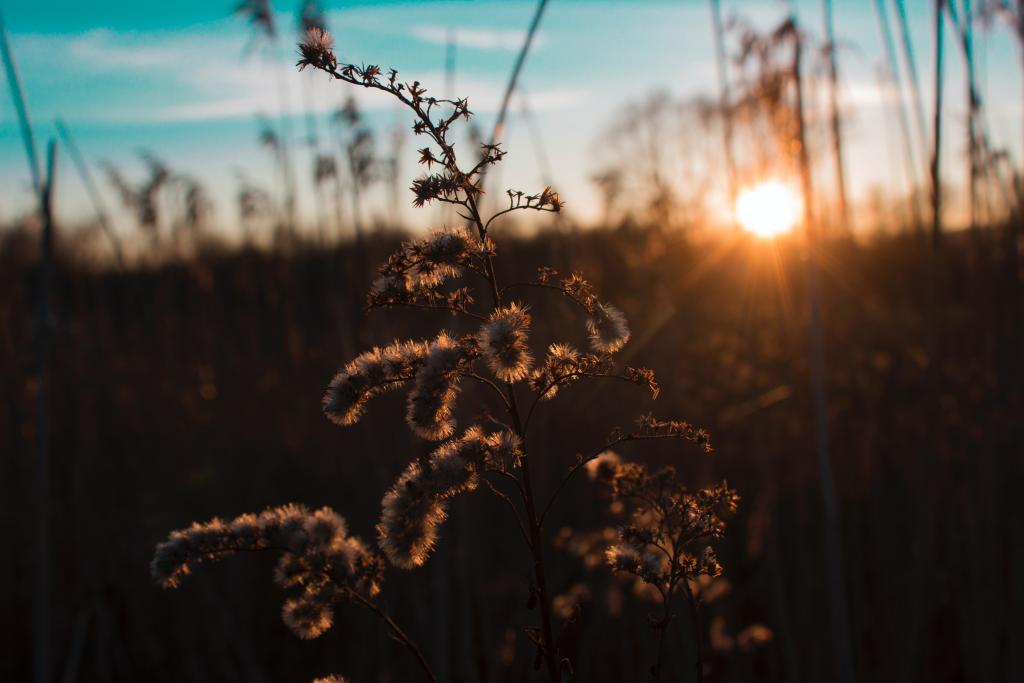
Within the world of agriculture, there is a vital part of crop growing known as letting land “lie fallow.” To fallow a piece of earth is to leave it deliberately unsown – to let it rest. This time of rest allows more fertility to gather in the soil, guaranteeing a better crop later. It is also sometimes used to avoid a surplus crop that might go to waste, or to let the soil and associated microbiota rest and settle for a bit after turning or plowing.
I tend to look for patterns in the green and growing world to inform my own practice. Understanding fallow time can be a helpful approach for spirituality when we’re feeling spent. And let’s face it – a lot of us are feeling spent.
The reserves of resiliency that many of us had access to prior to the pandemic have been truly run dry. The pendulum swing of Covid transmission rates, variants, and prevention strategies has taken a toll on our psyches. Many of us are grieving the loss of a loved one. Some of us are trying to manage complex, conflict-laden family dynamics around vaccination. Almost everyone is grieving the time we lost to this pandemic. It’s a lot, y’all.
I’m seeing the results of this ongoing state of tension in my clients, social circle, and greater community. Over and over again, the same refrain is sung: “I’m feeling disconnected.” My usual techniques for helping people reconnect to their spirituality are less helpful right now. It’s tough to make time to sit in front of an altar and journey when all you have energy for is collapsing onto the couch at the end of the day.
Winter is a fallow season, and it is well and truly here – Yuletide is just around the corner. Maybe we need to look to the land to teach us how to approach this time of spiritual, emotional, and psychological exhaustion.
How to Rest
It’s easy to assume that ‘getting more rest’ means ‘getting more sleep,’ and sleep is definitely important. There’s a blog on getting more and higher quality sleep here. However, rest is more than just closing our eyes at the end of the night. Rest is a cessation from doing. It’s a break from stimulation. In our wired, 24-hour-news-cycle world, we rarely pause to give ourselves a break from the whirligig of constant stimulation. Again and again, we answer the siren call of a world that howls to us for our attention. To allow ourselves fallow time, we need to find ways to pause the onslaught.
Mental Rest
Our minds take the greatest hit when it comes to the constant barrage of stimulation. Many of the activities we commonly think of as ‘restful’ – watching a movie or TV show, scrolling social media, or playing video games – are, in fact, stimulating. They do not allow the brain to fully take a break. We’re still in a position of making decisions, experiencing an emotional reaction, or otherwise being actively engaged by something that is deliberately designed to get our attention.
The widely used Pagan technique of grounding and centering is incredibly useful here. Experiment with taking a few moments of grounding and centering in the place of a stimulating activity like checking Facebook or Instagram. It can be especially useful to do this while sitting or standing by a window. Or, if you live in a place where the weather is reasonable and you have access to the outdoors, step outside and sit down on a bench or step to ground and center.
Another technique that can help is mindfulness. The word ‘mindfulness’ has a lot of buzz around it, but all it really means is becoming fully present. When we’re fully present, we’re not problem-solving or engaging in stimulation from an outside source. My favorite approach to mindfulness is to work through my senses. I start by simply closing my eyes and noticing Touch first – what is my body in contact with? Then I notice Sound – what do I hear? I follow with Sight, Smell, Taste, and add one last one: Spirit. I draw my awareness inward and focus on my heart center and notice what my spirit is feeling. Connecting with all of my senses brings me fully present. It also tells me useful things about how I’m feeling and what my body needs.
Breaking the cycle of seeking out constant stimulation takes practice. Start with small breaks for grounding and centering, mindfulness, or taking a walk. These pauses from strong sensory stimulation will give you a chance to recover a bit. Then, expand them. Experiment with longer breaks from stimulation as you become more comfortable with quiet.
Physical Rest
Letting our bodies rest involves more than our sleeping hours. One trick I learned in the Marines was to sit or lie down and close my eyes at any opportunity for a break. To this day, I’m a champion napper – I can fall asleep for 10 minutes or so and wake up refreshed. My schedule is no longer dictated by screaming NCOs wearing camouflage, but the lessons I learned about physical rest stay with me. My day includes 2 to 10 minute breaks where I simply sit down, set a timer for a few minutes, and close my eyes. The goal in that break is not to fall asleep, although it does sometimes happen. The goal is simply to let my body fully rest. As I close my eyes, I take a few deep breaths and do a quick body scan. I consciously relax any points of tension or discomfort I find. When my mind starts to wander, or tries to work on a problem, I notice and come back to taking deep breaths and consciously relaxing. When the timer goes off, I resume my day.
Another form of physical rest involves creating more ease in our bodies through activities that help them stretch out and heal. My own background in this area is yoga. There are a few different kinds of yoga that can be helpful here: Yin Yoga is a slow, low impact form of yoga that involves time spent in poses that benefit the ligaments, joints, and fascia. It allows for deep stretching and the release of tension from parts of the body that are otherwise difficult to access. Restorative Yoga is a style of yoga that actively encourages rest and uses yoga props like pillows, blankets, and blocks to help support the body in restful, releasing positions. There’s also an entire world of yoga that falls under the mantle of “Yoga for Relaxation.” The best part? There are hundreds of free videos on sites like YouTube including 10 to 15 minute ‘wind down before bedtime’ practices that you can try in the safety of your own home. A 10 minute investment in stretching can result in higher quality sleep and greater ease in your body. It’s definitely worthwhile.
Emotional Rest
How we manage our media greatly influences our emotional state. When we do engage with stimulating media whether it’s books, magazines, movies, television shows, or video games, we need to consider the emotional tone of what we’re consuming. We are already in an emotionally charged, alarming global pandemic with a climate crisis looming over us. Adding media that tells a story of a descent into darkness, amps up the adrenaline, or otherwise triggers feelings of danger adds to the emotional load we’re already carrying.
I’m not telling you to stop watching the action adventure movies (or whatever) you love, but I am suggesting that you do a check in before you engage. What do you emotionally need? If what you need is rest or rejuvenation, choose media that uplifts or informs without ratcheting up tension. I’ve been policing this more and more in my own life. There are a lot of movies I’d love to see, but I know they’ll just amp up my anxiety. So, right now, I’m focusing on anthropological documentaries, baking shows, and stand-up comedy. I don’t need help feeling bad – I do plenty of that on my own. What I require from my media right now is an emotional break or boost.
Repeat reading or watching can be a good fit here as well. The stories we love are comforting to us and when we know what’s going to happen, there’s no anxiety to manage. Consider grabbing one of your well-loved favorites and rereading it, or starting a marathon of beloved movies. Allow the times when you do engage with media to be more restful for your emotions.
Spiritual Rest
When a field lies fallow, it simply exists. It is open to the elements, to the sky, to the passage of the birds, insects, and mammals that live nearby. Our busy lives are largely sheltered from the rhythm of the natural world. When we are in a spiritually fallow season or time, we need to seek out connection without an agenda. This can be as simple as choosing to sit outside (bundled up if you’re in a part of the world where it’s cold right now) for a few minutes. It can be taking a gentle hike or walk on the weekend at a local park. Seek the wilderness, however much of it you can find near you. Simply be open to it. You do not need a goal like a certain number of steps to take, a specific view to reach, or a target heart rate. Allow yourself to be fallow, to be a human being rather than a human doing. Observe, be present, and allow.
One practice that helps me, particularly in winter, is locating and then visiting botanical gardens with conservatories/greenhouses/
Another activity that helps nourish my spirit is visiting art galleries. We all have different taste in art, so remember to do a little research if you’d like to try this one. I do not find modern art museums restful or rejuvenating, but I love Pre-Raphaelite art and find galleries displaying similarly themed work to be uplifting.
Simply put? Seek nature. Seek beauty. Then rest in those spaces.
Remember, there is nothing wrong with a fallow season. If you are having trouble engaging, feeling connected, or staying motivated, there’s a reason for it. Allow yourself to rest. Allow your psyche and spirit to take a break. The beautiful thing about fallow seasons is that when we do give ourselves permission to rest, the next season is fruitful. We may not be able to hibernate, but we can definitely turn down the stimulation for winter.
I wish you deep rest, beautiful dreams, and an abundant springtime to come. Want to add some suggestions for ways to rest and replenish? Hit me up in the comments. Your idea may be exactly what someone else needs.


















